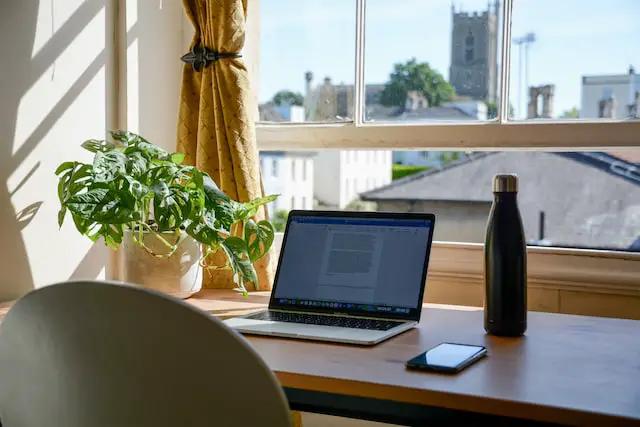Part of the beauty of remote work is that you can set up shop anywhere. But you also need to find the balance between being comfortable, staying motivated, and productivity. If you pull your laptop into bed with you, are you going to fall asleep? If you work from a coffee shop, are you going to be too distracted? On the flip side, working in a sterile environment without any comforts can make you less than excited to get your job done.
Whether you have an office set up in a coworking space or a corner of your bedroom, you spend a lot of time there. These tips will show you how to make your WFH office more comfortable while optimizing it for efficiency and productivity.
Get the Lighting Right
Don’t you love those Instagram photos where remote workers are set up with their laptops on the beach while drinking a margarita? While telecommuting provides a lot of freedom, the idea of working on the beach is usually a bit too optimistic. Besides the fact that sand in your keyboard could ruin your day, the glare from the sun makes it beyond difficult to see the screen. This means that you probably don’t spend nearly enough time in the sun as you should.

But lack of exposure to bright light during the day can mess with your circadian rhythm. Therefore, you should start by setting up your office with adequate lighting. Even if it’s a standing, portable, or floor desk, if possible, establish your desk in an area that gets indirect natural light from a window. You don’t want the rays to reflect off of your computer screen, and you don’t want to have to wear sunglasses while you work either. Angling yourself beside a window or covering the glass with a sheer curtain can give you an energizing space in which to work.
If your office is more mobile, get a clip-on light or small desk lamp that you can tote around with you. A warm bulb can also counteract the coolness from fluorescent lights. Grab a ring light if you spend time on virtual networking and meetings. Effective lighting can make you look more professional.
Use a Smart Assistant Device
You don’t always want to stop what you’re doing to record a note or set a reminder for an upcoming meeting. But most remote workers don’t have assistants to jot these things down for them. Keeping a smart assistant, such as Amazon Alexa or Google Assistant, handy can make you more efficient.
These assistants can be accessed via a mobile device, or you can by a dedicated device, like the Echo Dot or Google Home. Personally, I’m tied into Google quite heavily. I have a Google Home, and Google Pixel, and the entire infrastructure of my company runs on Google Workspace. It’s just so much easier to have it all connected.
You can add events to your calendar, set alarms to keep you on track, and even record your grocery list with a simple voice command. If you need to stay focused, ask the device to play meditation music. Whether your office is in one place or changes throughout the week, you can keep up with all of your pressing needs with a digital assistant.
Tuned in the right way, these helpers can make a world of difference when it comes to keeping you productive, regardless of where you’re working on any particular day.
Upgrade Your Posture
Most of us don’t have the best posture when we’re hunched over our desks. You want to be comfortable, but you don’t want to encourage poor spinal alignment. If you don’t have an ergonomic setup, you can set yourself up for plenty of discomforts in the future.
Standing desks have become a popular option for anyone who works in an office. Staying upright can help you feel more energetic. You might be more likely to run to the printer and grab that stack of papers instead of putting it off. Adding a treadmill beneath the desk can also help you burn calories while you work.
But if you’re going to switch to a standing desk, take your time. Start with 30 minutes a day, gradually increasing the standing sessions. This will allow your muscles to get used to the new position and reduce the chances of soreness or strain.
Try placing an anti-fatigue mat under your feet if you’re standing for most of the day. This can relieve pressure from your joints and keep you comfortable. A grounding mat is intended to create an electrical connection between the earth and your body, potentially improving your health and energy levels.
You can also swap out your desk chair for a more ergonomic one. Large, inflatable exercise balls make excellent chairs that support your pelvis and allow you to sit actively. Investing in a supportive office chair that has adjustable settings can ensure that you maintain the proper alignment while sitting at your desk.
If you don’t have the option to schlep a chair to a coworking space or coffee shop, consider using a pillow for added support. Foam wedges can be placed in multiple areas. Tuck one under your hips or sandwich it between your lower back and the chair to relieve pressure points and stay comfortable as you work.
Create a Break Spot
Although it seems counterintuitive, working without stopping makes you less productive. Sure, you can pack more tasks into a given time frame if you don’t take a break, but your performance will likely suffer. No one can work nonstop and be just as productive as when they first started their day.
Breaks are important for productivity because they:
- Reduce stress
- Prevent burnout
- Improve morale
- Enhance your health
- Boost cognitive functioning
Are you taking breaks during the day? If so, are you doing so in a constructive manner? Plopping on the cough and flicking on the TV might not be the most effective way to unwind after looking at a computer screen for hours. But eating lunch at your desk doesn’t give you much relief.
Create a spot where you can take a brain break from time to time. For me, it’s my balcony. I basically live on top of a highway, so I’ll go out there and listen to traffic, watch the crazy drivers, and sit on my patio furniture while I recharge.
Perhaps you can add a comfortable chair to the corner of your office or place a yoga mat and some pillows in a nook near a window if you don’t have a balcony. Encourage yourself to take at least one 5-minute break every hour. Curl up with some tea, listen to an inspiring video or podcast or close your eyes and meditate. Your breaks will feel more meaningful, and you’ll be more motivated to get back to work afterward.
Incorporate Plants into Your WFH Office!
Plants can be a good mental and aesthetic addition to a home office. Plants can have a number of benefits for both productivity and well-being. Here are a few ways that plants can benefit a home office:
Improve air quality: Plants can help to purify the air by absorbing pollutants, which can improve overall air quality in the home office.
Reduce stress: Having plants in a home office can help to reduce stress and improve mood, by providing a sense of connection to nature and promoting relaxation.
Increase focus: Studies have shown that having plants in a work environment can help to increase focus and concentration.
Improve aesthetic: Plants can add visual interest and beauty to a home office, making it more pleasant and inviting to work in.
Personal touch: Plants can add a personal touch to your home office and can reflect your personality and taste.
I would suggest staying away from most plants that require a lot of sunlight, as those are hard to maintain inside a WFH office. Some low-maintenance plants that are suitable for indoor spaces are Spider Plant, Snake Plant, and Pothos.

Charge Yourself Up
Between your laptop, monitor, mobile device, lamp, speakers, and digital assistant, you likely need lots of places to plug in while you work. It can be frustrating to find that the only available outlet is taken.
Set up your workspace with all of the outlets that you need to keep your electronic devices at arm’s reach. This might involve reworking your wiring if you’re operating from home. In most cases, adding a power strip with a surge protector can help. Many come with outlets to charge USB devices. My personal setup is a bit silly…I have a surge protector hidden by a table I work from. That surge protector has several wires that run into a shoebox that I poked holes in so the wires could run wherever they needed to. It’s a little ridiculous, admittedly, but it works like a charm. I can charge anything I would possibly need while working from the table.
Carry an extra set of charging cords and plugs with you if you travel for work. Having to search the house for a charging cable before you head to a meeting is distracting and wastes precious time. I have a little tri-fold packet that has several wires inside it. I carry it (plus a power bank) everywhere so that I’m always ready to charge up if I need to unexpectedly.
Control the Temperature
If you work for several hours at a time without moving around much, your typing fingers can get chilly. On the other hand, working in a warm environment can make you sleepy. Keep the temperature in your environment comfortable so that you can work freely.
This might mean carrying a portable fan with you to your coworking space or setting up a small space heater to keep your toes warm. You might also want to have various layers of clothing handy so that you can change into a T-shirt or throw on a sweater if you can’t change the thermostat. Tucking a blanket into your work bag can also be useful in a pinch.
When you know how to make your office more comfortable, you’re also more productive and satisfied with your work. As a remote worker, you have more flexibility than most people. Take advantage of that and create an office that corresponds with your working style.
Jared has worked remotely for 15 years in various marketing capacities, and has managed hundreds of marketing campaigns along the way. He has held freelance, agency, and in-house positions for companies large and small.


